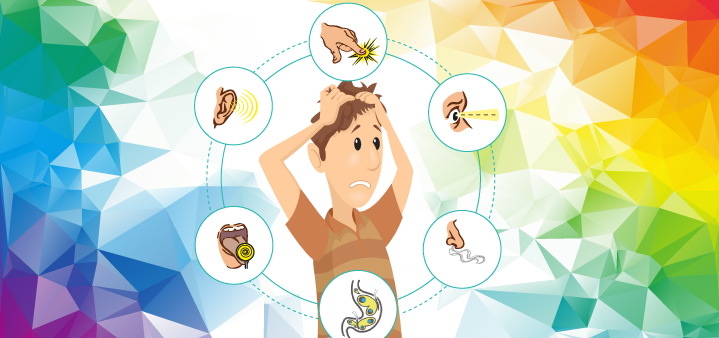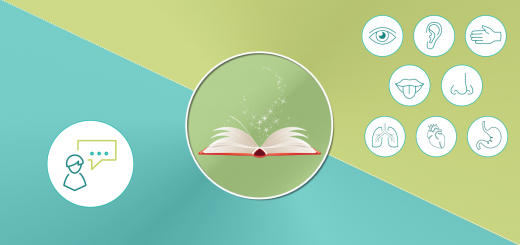Do our thoughts make us suffer? Five types of mental activities
2Every moment of every day you are bombarded by information from outside and inside of your body. You take outside information in via the senses (it’s called perception) and internal information via sensations (it’s called interoception). It is the job of your brain to interpret this information, and it issues its best guess about what it is based on your past experience.
According to Lisa Feldman Barrett, PhD and Professor of Psychology, “All sensory information is a massive, constantly changing puzzle for your brain to solve. The objects you see, the sounds you hear, the odors you smell, the touches you feel, the flavors you taste, and the interoceptive sensations you experience as aches and pains and affect . . . they all involve continuous sensory signals that are highly variable and ambiguous as they reach your brain. Your brain’s job is to predict them before they arrive, fill in missing details, and find regularities where possible, so that you experience a world of objects, people, music, and events, not the “blooming, buzzing confusion” that is really out there.”(1)

“To achieve this magnificent feat, your brain employs concepts to make the sensory signals meaningful, creating an explanation for where they came from, what they refer to in the world, and how to act on them.” Your brain sorts all input into categories, and this categorization “constructs every perception, thought, memory, and other mental event that you experience.”(1)
All this categorization happens behind the scenes and you are not consciously aware of it. What you are aware of is the constant stream of thoughts in your head, the inner monologue that evaluates the things that you experience inwardly and outwardly, and accesses how they will affect you, the main character of the story. This is a normal activity of the brain, and with all its busyness there are only five types of mental events that you can engage in (according to Patanjali’s Yoga Sutras).
The five types of mental activities are: correct assessment (pramana), incorrect assessment (viparyaya), imagination (vikalpa), deep sleep (nidra) and memory (smrtayah). This means that at any point of any day you are either interpreting your experience (correctly or incorrectly), imagining things that do not exist, sleeping without dreams, or reminiscing about something that happened in the past. So basically in your waking state you are either evaluating something, imagining something or remembering something.
All of this happens through the lens of your own past experiences, beliefs and character so it is highly subjective. “Your perceptions are so vivid and immediate that they compel you to believe that you experience the world as it is, when you actually experience a world of your own construction.”(1) The same point is communicated by a widely known expression: We don’t see things as they are, but as we are.
And even though yoga, Buddhism and other traditions frown upon the “monkey mind”, by itself those types of mental activities are neither good nor bad, they are just the result of the brain’s process of categorization. And the fact that we are so preoccupied with ourselves and our own story is also neither good nor bad – your brain is mostly concerned with YOUR survival and thriving, so it is always evaluating the impact that things will have on YOU.
It is the job of your brain to interpret all the input, and it issues its best guess based on past experience. “I am hungry’, “I have a headache”, “I am nervous” ,“My neck hurts” are your brain’s interpretations of your inner sensations. Some of those interpretations are correct and some are incorrect. Are “incorrect perceptions” bad? If we could only figure out a way to assess the situation properly, diagnose the condition accurately, figure out what is REALLY going on and then fix it, wouldn’t that prevent us from suffering? Not really. While correct diagnosis would certainly help with choosing an appropriate treatment, in many situations there are no right answers, just informed (or un-informed) opinions.
As Patanjali states in the Yoga Sutras, either of those five mental activities (correct and incorrect assessment, imagination, deep sleep and memory) can be klishta (cause trouble, suffering) or aklishta (not cause trouble and suffering).
Any thought you have can be benign and not have much impact on your life, or it can make you suffer. According to Yoga Sutras, our mental activity will make us suffer if we begin to define ourselves through it. If you define yourself as a starving artist, for example, you will think and behave as a starving artist; if you define yourself as a sick person, you will think and behave as one, and so on. It is not about the thoughts themselves, but how they feed into your inner narrative and perception of self.
If several of those mental activities keep feeding you the same message, it will have even stronger impact. Let’s say you’ve experienced lower back pain for a long time (correct assessment). Your brain might begin to interpret other types of sensations, like stress or stiffness, as lower back pain (incorrect assessment). You cannot remember what it feels like to not have the pain (memory), and you cannot imagine it ever getting better (imagination). If this has become the lens through which you see the world, your life and your sensations, it will cause you physical and emotional suffering. Through no fault of your own, your chronic back pain becomes part of you.
How do we break this identification? The entirety of Patanjali’s Yoga Sutras is dedicated to that, and over the next few weeks we will discuss different strategies. But here is the most important idea that we need to cultivate for ourselves and our students: I am not my pain. This is a fundamental change in how you perceive yourself. Instead of defining yourself through your pain or a diagnosed condition, you can work on perceiving yourself as a person who experiences painful symptoms. Then it becomes a temporary condition rather then permanent quality. This kind of change in perspective can help change the status of pain from an all-consuming entity that defines your life to something that is manageable and can be dealt with. It is usually very empowering for students.
Tune in next week as we discuss the most effective yogic tools for dealing with those kinds of identifications.
![]()
 Sequence Wiz members will get a PDF handout with description of all five mental activities as defined by Patanjali’s Yoga Sutras on Friday. It will be located under Forms and Handouts.
Sequence Wiz members will get a PDF handout with description of all five mental activities as defined by Patanjali’s Yoga Sutras on Friday. It will be located under Forms and Handouts.
Learn more about Sequence Wiz membership >
Resources
- How Emotions Are Made: The Secret Life of the Brain by Lisa Feldman Barrett




















What a great piece to start my day with; thank you!!
Dear Olga,
Thank you so much for another very thoughtful blog.
I always read your blogs and really enjoy them, as they often remind me of thoughts or practices I
had forgotten …
Thank you and all the very best wishes to you for the Holidays and for this coming year. May it be a healthy and happy one for ALL!
Hanna